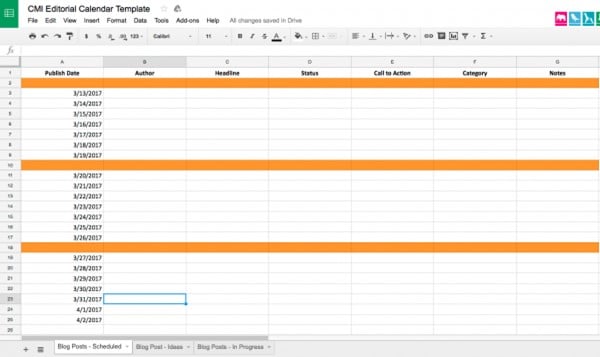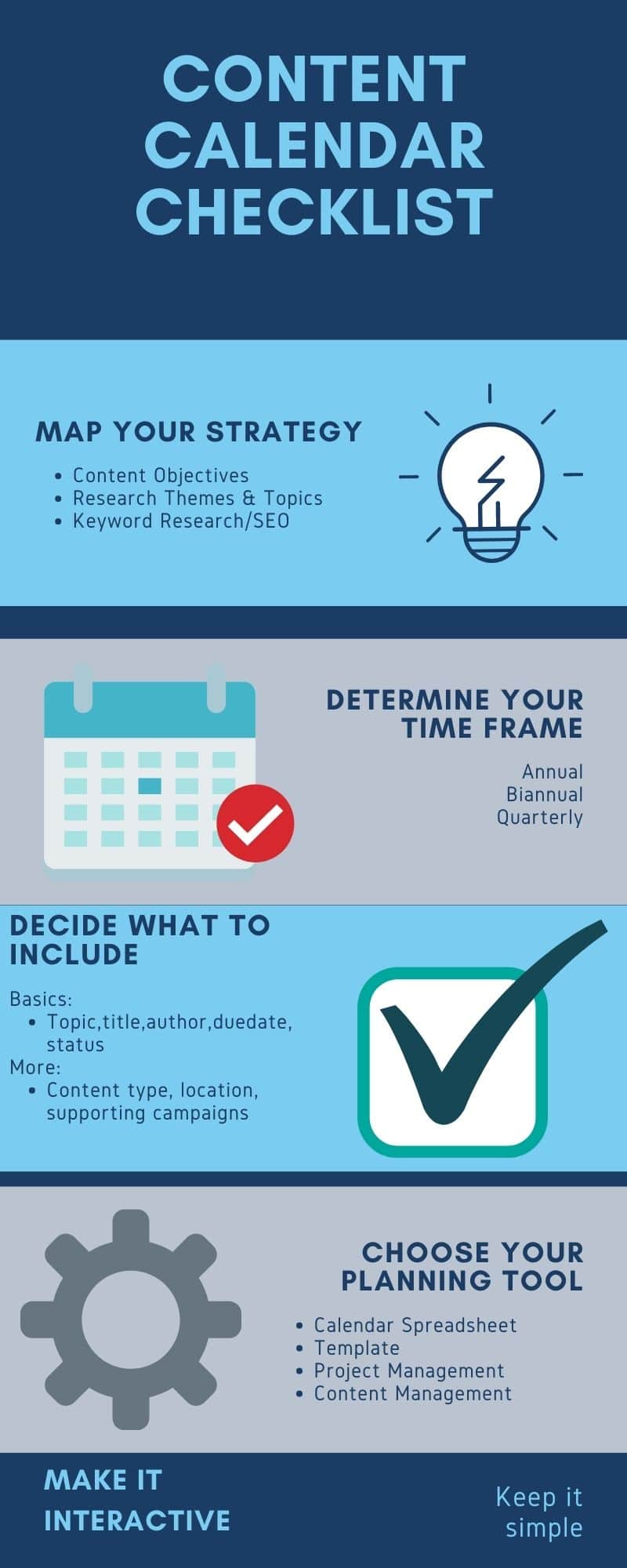
HOW TO CREATE AN EFFECTIVE CONTENT CALENDAR
HOW TO CREATE AN EFFECTIVE CONTENT CALENDAR
“Content is king, but distribution is queen.” —Jonathan Perelman
Perelman’s famous Buzzfeed pronouncement is truer than ever in 2021. With the proliferation of quality content competing for consumers’ attention across every platform and channel, the need for marketers to have a strategic, regular flow of content only continues to increase.
It’s no secret that consistent, relevant content is crucial to build visibility, authority, engagement, and results for your brand. Regular content distribution is consistently ranked among the most important characteristics of successful content marketing.
But feeding the proverbial content beast is still a big challenge.
Sixty percent of marketers surveyed in a recent Hubspot survey said they had difficulty producing content consistently.
According to Review 42, one in five marketers said they knew the best way to run a content campaign. Only 46 percent had a documented strategy for content management.
The solution is a content calendar–a centralized planning tool for scheduling and publishing your content. But while savvy marketers recognize the need, it can be confusing to navigate the options and the process.
According to the Semrush 2020 State of Content Marketing Report, “How to create a content marketing calendar” was among the top 20 content marketing questions asked on Google in 2020.
What’s a content calendar?
“Simply put, the content calendar is the implementation plan for your content strategy,” says Ann Gynn, Editorial Consultant for the Content Marketing Institute. It’s an interactive tool for planning, organizing, and scheduling content. It’s a single, central repository for detailed, day-to-day content management, providing visibility, access, and accountability across contributors and teams.
An effective content calendar specifies content type, title, location or destination, writer, due date, status, and other critical information.
Depending on the size of your organization and the complexity of your needs, it may also help coordinate with other media and supporting campaigns and/or track results.
Why do you need one?
Content strategy and content management are not the same thing. A brilliant content strategy alone is not enough without a system for seamless execution and distribution. An effective calendar is the planning tool that ensures consistency, and it’s crucial to your success.
Key benefits include:
- A regular flow of strategically planned content
- A single streamlined system for tracking content creation and distribution
- Consistency across channels and effective coordination with other media, supporting campaigns, and promotions
- Improved search rankings
- Ability to track performance and results
But content calendars aren’t one size fits all. You’ll get the best results with a calendar customized to your specific needs, and there are many available options.
How do you create a content calendar?
With some thoughtful strategizing and planning, the calendar development process doesn’t have to be daunting. Let’s look at it step by step.
Determine your content strategy
First, define your strategy. What are your content priorities? Traffic, lead generation, conversion? Branding or thought leadership? Improved SEO? Every piece of content you publish should have a specific purpose. Clarifying your objectives will help determine how simple or complex your calendar needs to be.
Decide on your time frame. Are you planning monthly, quarterly, or annually? Gynn recommends quarterly, at a minimum. She suggests planning annually by mapping out the first six months in detail on your calendar while keeping a general list of themes or topics you can flesh out as the second half of the year approaches.
Research industry and audience trends to determine content themes and topics. You can analyze top-performing content in your niche using tools like BuzzSumo or Social Animal to identify popular topics and formats as well as effective headlines.
Brainstorm with your sales, marketing, and customer service teams to develop content ideas. What issues matter most to your prospects and customers? Identify the stages of your customer journey so you can map content effectively to meet leads, prospects, and customers at each step of the buying cycle.
Do keyword research to optimize search rankings. Search engines reward brands that publish consistent content. A regular flow of keyword-optimized content boosts visibility, page rankings, lead generation, and conversion. Keywords can also help you generate content themes.
What should your calendar include?
Now that you’ve laid out your content objectives, you can decide what information to track with your calendar. The basics include:
- Content theme or topic
- Title
- Content type (blog post, video, social post, email, podcast, PDF, infographic, quiz, contest, email newsletter, whitepaper, case study, etc.)
- Website location or destination (social channels, YouTube, etc.)
- Frequency
- Author
- Due date
- Publish date
- Status
- Assets needed (graphics or images)
- Relevant links or resources
You may also want to specify supporting media, campaigns, and promotions; seasonal, promotional, evergreen, or repurposed content; and whether a Call To Action is included. Consider including a space for future content ideas.
Choose your calendar format
Once you’ve decided what information to track, you can decide on a calendar format. The options range from simple spreadsheets to fully interactive content management platforms.
Spreadsheets
Spreadsheets like Google Sheets or Excel are popular free options for individuals and small teams because they’re simple, customizable, and interactive. They can also work in conjunction with calendar apps and content management tools, allowing you to coordinate information in multiple locations.
Calendar Apps
A traditional calendar or calendar app like Google Calendar is another convenient option. As a straightforward method of tracking what’s going out when, it can also be shared across teams and coordinated with Google Docs and Google Sheets. This format is well-suited to smaller teams and enterprises.
Templates
Templates like the one below from the Content Marketing Institute are essentially basic formats you can customize with your own categories, so you don’t have to start from scratch.
This Hubspot article also offers a good overview of available free templates.

Project Management Tools
Project management solutions like AirTable and Trello are more visually-oriented collaboration tools for tracking multiple simultaneous projects. Trello’s Kanban-based system uses moveable cards.
Content Management Platforms
Platforms like CoSchedule are more robust solutions that track every detail of planning, creation, and distribution. They’re generally appropriate for larger teams and more complex content management.
Importantly, the more sophisticated platforms can also track content performance and measure results. Analytics and metrics are increasingly important in content marketing. “There’s a growing expectation from business leadership that content must prove its value,” says Gynn. “You need to have some metrics, whether it’s website visitors, conversions, SEO, whatever it is.”
Regardless of which tool you choose, it should be interactive. Your calendar is a single source of truth designed to streamline communication and give everyone involved visibility and accountability. “Too often people think of it as a static document and don’t use it to their advantage,” says Gynn.
And keep it simple. “Pick a tool that’s as robust as you need it to be, but also as simple as you can make it,” says Gynn. If your only content is blog posts, your calendar may only need to include the title, writer, due date, and publish date. As your content evolves and becomes more complex, you can add categories and functionality. “if you’re a team of two and you think you might expand to a team of four, be thinking about room for growth going forward,” she says.
Your Content Calendar: Turning Strategy into Successful Execution
The best advice for creating your content calendar may well be the famous Nike slogan: Just do it.
Gynn says the biggest challenge for marketers is often simply creating the calendar–and then actually using it. Many marketers, initially enthused about the prospect of having fully planned and scheduled content, get busy with day-to-day demands and don’t always follow through.
It doesn’t have to be a daunting task. With some upfront planning and the many available options, planning and executing a consistent publishing schedule is achievable—and well worth the effort.
With a clearly defined strategy, research, and an understanding of your needs, you know what content to publish, when, and why. You know what information to track with your calendar and which planning tool best suits your needs.
Now you can plan and execute your content strategy with every detail accounted for—and reap the rewards of content that delivers results.

Related Content
- 0 Comment
Subscribe to Newsletter
- How Can SharePoint Be Used To Organize and Disseminate SOPs?
- Planning the Perfect Genealogy Research Trip: A Step-by-Step Guide
- From Silly to Awesome: How Words Change Meaning Over Time
- The Psychology of Font Choice: How Typography Impacts Content Engagement
- How to Distribute SOPs for Maximum Usability


